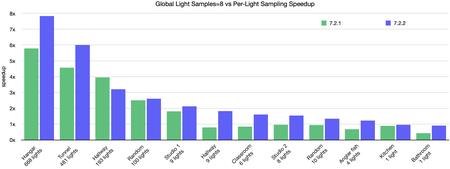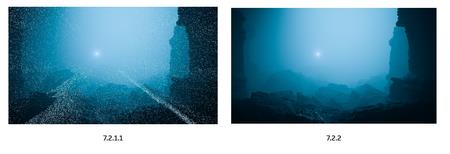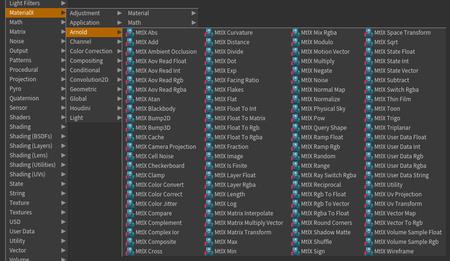Solid Angle Houdini to Arnold 6.2.2.0 (x64)

Free Download Solid Angle Houdini to Arnold 6.2.2.0 | 6.6 Gb
Owner:Solid Angle (now part of Autodesk)
Product Name:Arnold for Houdini (HtoA)
Version:6.2.2.0
Supported Architectures:x64
Website Home Page :www.arnoldrenderer.com
Languages Supported:english
System Requirements:Windows, Linux & macOs *
Size:6.6 Gb
The Solid Angle Team is pleased to announce the availability of Arnold (or HtoA) 6.2.2.0 for Houdini is a feature release using Arnold 7.2.2.0.
Enhancements
-Improved interactivity when modifying large scenes:Arnold 7.2.2 improves the responsiveness of the renderer when modifying large scenes interactively. When editing lights or shaders in scenes with millions of instances, the time to first pixel is nearly instantaneous instead of having to wait multiple seconds. For example, this change improves interactivity greatly when rendering scenes using the point instancer in USD. Modifying nodes during an interactive session now usually results in an update of just the modified node, not of all nodes. In scenes with many nodes, this can substantially speed up interactive node updates. In case of missing updates, you can disable this feature by setting options.enable_fast_ipr to false. An Arnold cache flush can also be used to trigger all nodes to update again. (ARNOLD-4873)
-Improved global light sampling performance:The efficiency of global light sampling with indirect lighting has been improved in many cases. See the global light sampling documentation for more details. (ARNOLD-13381)

-Reduced numerical precision differences across CPU vendors:While images rendered on Intel, AMD, and Apple CPUs were already often perceptually equivalent, we have removed more precision-related differences so that even more results are now perceptually identical. (ARNOLD-5211)
-Reduced noise from mesh lights in volumes:The amount of noise in volumes when using a mesh light with very small triangles is now much reduced. (ARNOLD-11880)

-Display render status annotation in Solaris:The estimated remaining render time is now shown as a viewport annotation in Solaris, as well as the current Arnold render status. This lets you know that Arnold is still working during potentially long-running operations like compiling shaders. HTOA-2133

-Houdini MaterialX node support:Houdini MaterialX nodes (such as Mtlx Ramp) now work in Arnold. HTOA-2183

-Support filtermaps in Solaris:Camera filtermaps and uv_remap shaders are now supported. HTOA-2165
-Added the per-geometry subsurface autobump visibility attribute:The subsurface autobump visibility parameter is now available in the Arnold Object properties and the Render Geometry Settings LOP. The deprecated "Autobump for SSS" attribute was removed from the Arnold ROP. HTOA-2197
-Improved help and icons:Consistent icons, help, and tab menu across various ROP, OBJ, LOP, and MAT nodes. HTOA-2217 HTOA-2175

-Specify which AOV to show in kick display:A new kick flag -aov selects the AOV to show in the kick display window. (ARNOLD-13360)
-OCIO color manager handles better missing configs:If the OCIO color_manager is not given a config filename and the OCIO environment variable is not defined, Arnold will now use the builtin config. Previously it would fail with a warning and not apply any color conversions. (ARNOLD-11565)
-Per shape autobump SSS visibility:You can now control whether autobump is visible on SSS for specific shapes, instead of relying on the global control, just as you can for the other autobump visibility controls. This setting has subtle effects and can increase rendering times, so enabling it only where it matters will help optimize scenes. (ARNOLD-12989)
-Update CER:The Customer Error Reporting (CER) library is updated to v6.2.3. (ARNOLD-13510)
USD Enhancements
-Load 3rd party MaterialX node definitions:It is now possible to render MaterialX nodes defined in third-party node definitions using the ARNOLD_MATERIALX_NODE_DEFINITIONS environment variable. (ARNOLD-13398)
-Estimated render time in the Render Delegate:Add Arnold render status and estimated render time to viewport annotation. usd#1492 -
-Camera filters:Add support for camera filtermap and uv_remap. usd#1499
-Deterministic USD prototype names:This change forces USD to generate non-random prototype names for instances when using the USD_ASSIGN_PROTOTYPES_DETERMINISTICALLY environment variable. This addresses frame stability issues when using Cryptomatte. (ARNOLD-13349)
-Material scope:Add a Mtl scope for materials when authoring usd file. usd#1486
-Subsurface ray visibility:Add AI_RAY_SUBSURFACE visibility flag support in the render delegate and procedural. usd#1529
API Additions
-AiMallocUsableSize():AiMallocUsableSize() returns how much memory a pointer returned by AiMalloc() is using. This is helpful when paired with AiAddMemUsage() for tracking memory allocation and deallocations. (ARNOLD-13354)
-Per-object subsurface autobump visibility:The per-object autobump_visibility flag AI_RAY_SUBSURFACE now toggles the appearance of autobump normal perturbations in subsurface scattering effects. (ARNOLD-12989)
-Support ARNOLD_MATERIALX_NODE_DEFINITIONS in AiMaterialxGetOslShaderCode:The AiMaterialxGetOslShaderCode function will now respect the value of the ARNOLD_MATERIALX_NODE_DEFINITIONS environment variable, and also supports an optional MATERIALX_SEARCH_PATH argument to load 3rd part MaterialX node definitions. (ARNOLD-13398)
-Forcing node updates:To force a specific AtNode type to be always updated, you can set the boolean metadata force_update to true on the node : AiMetaDataSetBool(node_entry, nullptr, "force_update", true); (ARNOLD-4873)
Incompatible changes
-Deprecated sss_use_autobump:The sss_use_autobump global option is now deprecated in favor of the per-object autobump_visibility flag. While the global option still works, it now prints a warning when used, and will eventually be removed. (ARNOLD-12989)
Bug Fixes
HTOA-2056 - Subnet traversal issue in husd shader translation
HTOA-2152 - Fixed 'Bad parameter reference' warnings when rendering with Solaris
HTOA-2186 - Fixed different velocity blur if packed alembic includes a transform
HTOA-2211 - Fixed stracktrace when saving a new scene containg a USD Render LOP
ARNOLD-11789 - AiAOVSampleIteratorGetInvDensity for non-adaptive renders was always 1
ARNOLD-11880 - Bright pixel artifacts in atmosphere_volume when using a mesh light with very small triangles
ARNOLD-11888 - OIDN doesn't work if noice denoising AOVs are also output
ARNOLD-11900 - AOV samples memory stats report negative value and large unaccounted memory
ARNOLD-12774 - Support multipart scanline EXRs
ARNOLD-13346 - Set_transform in append mode only considers the first matrix key
ARNOLD-13376 - Crash when modifying a mesh referenced by an instancer node
ARNOLD-13460 - Strip _forced_box_filter from .ass export
ARNOLD-13463 - UDIM tiles greater than 1009 do not render with MaterialX image nodes
ARNOLD-13495 - Hang when reading corrupt .ass file
ARNOLD-13511 - RLM_DEBUG env var prints weird characters
ARNOLD-13512 - Incorrect values in Arnold MaterialX Node Definitions
ARNOLD-13523 - Fix slowdown when using big arrays of nodes with the dependency graph enabled
ARNOLD-13539 - Log messages from AiScene API incorrectly reference "[ass]" when .ass file are not used
ARNOLD-13550 - Quad light sometimes produces NaN artifacts
ARNOLD-13615 - AutoTX occasionally uses wrong colorspace
usd#1502 - Render delegate crashes with empty arrays
usd#1522 - Support UsdPrimvarReader_float2 shader returning the st variable
usd#1530 - Fix a crash when a user primvars has an empty array on a keyframe
Arnold from Autodeskis an advanced unbiased Monte Carlo ray tracing renderer. It uses the power of your CPU to calculate illumination in the scenes by default. You can, however, switch between CPU and GPU rendering depending on your needs. Arnold is famous for its staggering hyperrealistic renders, which is why it's perfect for creating cinematic shots. When you have a massive amount of fine detail in your scene, when you're dealing with intricate textures, or when your lighting setup is complex, a precise renderer like Arnold will ensure that none of your hard work goes unnoticed. Think of the stunning visuals of Blade Runner 2049, Guardians of the Galaxy, or Tim Burton's Alice in Wonderland - all three were rendered using Arnold.
Arnold for Houdini (HtoA)provides a bridge to the Arnold renderer from within the standard Houdini interface. Having been in beta for several months, the plugin has already been used in production by many studios, including Prime Focus World for Hercules and Vampire Academy, Milk VFX for the Sherlock and Doctor Who TV series, and Framestore NY for the Captain Morgan commercials.
Houdini to Arnold Teaser
Teaser of the upcoming tutorials about Arnold for Houdini. I will be making a digital asset Arnold "uber" shader, showing how to make layered materials, explaining the general setting and at the very end texturing, rendering and multi-pass comping a Ferrari 458 Italia in NukeX. Available in 4k UltraHD
Solid Angleis leading provider of rendering software for animation and visual effects. The Arnold team believe that accurately and efficiently computing light transport in CG scenes is the best way to create stunning imagery for films and TV. Developers strive to provide clients with the best rendering tools to efficiently create realistic images. Solid Angle is a wholly owned subsidiary of Autodesk Inc, and has its offices in Madrid and London.
Autodeskhelps people imagine, design and create a better world. Everyone-from design professionals, engineers and architects to digital artists, students and hobbyists-uses Autodesk software to unlock their creativity and solve important challenges.
Rapidgator-->Click Link PeepLink Below Here Contains Rapidgator
http://peeplink.in/ab2009e3010e
Uploadgig
ov9yv.setup.part1.rar
ov9yv.setup.part2.rar
ov9yv.setup.part3.rar
ov9yv.setup.part4.rar
NitroFlare
ov9yv.setup.part1.rar
ov9yv.setup.part2.rar
ov9yv.setup.part3.rar
ov9yv.setup.part4.rar
Links are Interchangeable - Single Extraction
